Table of Contents
ToggleUDISE Plus: A Comprehensive Overview of India's School Information System

India’s education sector is pivotal to shaping the nation’s future, and efficient systems are necessary to monitor school performance and infrastructure. UDISE Plus (Unified District Information System for Education Plus), introduced by the Ministry of Education, plays a vital role in collecting, managing, and analyzing data from schools nationwide. This platform has modernized the way educational data is handled, aiming to streamline the process and ensure transparency for more informed decision-making.
In this blog, we will explore the workings of UDISE Plus, its key components, and its significance in improving the education system in India. We will also discuss recent upgrades, such as the Apaar module, which has enhanced the system’s functionality.
What is UDISE Plus?
Launched in 2018, UDISE Plus is the upgraded version of the UDISE system, which was first implemented in 2012 to gather data at the district level. However, with the evolving needs of the education sector, UDISE Plus emerged as a more robust, real-time system for capturing detailed data at the school level.
The primary objective of UDISE Plus is to ensure that all schools in India, whether government, aided, or private, can provide essential data for planning and decision-making. This system collects information on various aspects, including school infrastructure, enrollment rates, student demographics, and teacher qualifications.
Key Modules of UDISE Plus
UDISE Plus operates through multiple modules that collectively offer a comprehensive view of the functioning of schools. Here are some of its key modules:
School Profile Module: This module gathers essential details about the school, such as location, type (government, private, aided), and medium of instruction. It also collects data on available facilities like toilets, playgrounds, and drinking water.
Student Data Module: This module records student enrollment data, including age, gender, caste, and disability status. It helps track demographics, essential for creating inclusive policies targeting marginalized groups.
Teacher Data Module: UDISE Plus also collects comprehensive information about teaching staff, covering their qualifications, training, and experience. This aids in identifying gaps in teacher training and developing professional growth plans.
Infrastructure Module: Schools report on physical infrastructure, including classrooms, laboratories, libraries, and ICT resources like computers. This information is crucial for planning upgrades and ensuring schools have adequate facilities.
School Grants Module: This module monitors the financial aspect of schools, tracking how they utilize government grants. This includes funds for infrastructure, midday meals, and other student welfare programs.
Learning Outcomes Module: One of the most important modules, it collects data on student performance in subjects like mathematics, science, and language. This helps assess learning levels and develop strategies to improve educational outcomes.

The Need for UDISE Plus
Why is a system like UDISE Plus necessary? In a country as large and diverse as India, managing data from millions of schools is no small task. Previous systems often suffered from inaccuracies and inefficiencies, but UDISE Plus addresses these issues by improving data accuracy, reducing errors, and streamlining data collection. Here are a few reasons why UDISE Plus is so crucial:
Real-Time Data Collection: UDISE Plus allows for real-time data collection, ensuring that information is up-to-date and actionable.
Error Reduction: The digital tools used for data entry in UDISE Plus minimize human errors, leading to more reliable data.
Better Planning: The data gathered through UDISE Plus supports better policymaking. For instance, data on student enrollment can help predict future needs for classrooms, teachers, and learning materials.
Transparency: The system ensures transparency in how government grants are used and the overall functioning of schools, reducing corruption and ensuring that funds are used to enhance education.
Inclusive Policies: UDISE Plus captures data on gender, caste, and disability, ensuring that marginalized communities are considered when developing educational policies.
The Importance of the Apaar Module
The Apaar module, one of the most recent additions to UDISE Plus, is focused on improving accessibility for students with disabilities. “Apaar” means “limitless” in Hindi, symbolizing the module’s aim to provide limitless opportunities for students with special needs, removing barriers to their education.
Tracking Special Needs Students: The Apaar module enables schools to record data on students with disabilities, including the type of disability and the specific support they require. This ensures these students receive the necessary resources.
Resource Allocation: Detailed data on students with disabilities allows for more effective resource allocation. Schools with a higher number of special needs students can receive additional funds for specialized equipment or teachers trained in special education.
Inclusive Infrastructure: This module also tracks the availability of infrastructure designed for special needs students, such as ramps, specialized classrooms, and adapted learning materials.
UDISE Plus and Future Prospects
Since its introduction, UDISE Plus has transformed how data is collected and utilized in India’s education sector. The system has enhanced transparency, improved planning, and ensured that resources are used efficiently. With new modules like Apaar, UDISE Plus is becoming increasingly inclusive, addressing the needs of diverse student populations.
As we look to the future, UDISE Plus will continue to play a pivotal role in shaping education policy and ensuring that all students, regardless of background or ability, have access to quality education. Whether it’s improving school infrastructure, focusing on learning outcomes, or fostering inclusivity, UDISE Plus is at the core of these efforts.
In conclusion, UDISE Plus is not just a data collection platform—it is a key resource in driving improvements in the quality of education across India. With continuous updates and the addition of innovative modules like Apaar, UDISE Plus is set to make the education system more efficient, inclusive, and ready for future challenges.
Frequently asked questions (FAQs) about UDISE Plus:
What is UDISE Plus and how is it different from the previous UDISE system?
UDISE Plus (Unified District Information System for Education Plus) is an upgraded version of the UDISE system that was launched in 2018. While the earlier UDISE system gathered data at the district level, UDISE Plus collects more detailed, accurate, and real-time data at the school level, covering both government and private institutions. It offers improved data accuracy, error reduction, and real-time data collection for better educational planning and decision-making.
2. What type of data does UDISE Plus collect?
UDISE Plus collects a wide range of data including school infrastructure, student enrollment, teacher qualifications, school grants, and learning outcomes. The system covers multiple areas such as school profiles, physical infrastructure, teacher and student demographics, and financial data, allowing policymakers to create more effective strategies for improving education across the country.
3. How does UDISE Plus improve the planning and management of education?
UDISE Plus helps policymakers plan more effectively by providing accurate, real-time data. For example, data on student enrollment trends can help predict future needs for classrooms, teachers, and learning materials. It also ensures that school resources, grants, and facilities are monitored closely, allowing for better resource allocation and reducing inefficiencies.
4. What is the Apaar module, and how does it contribute to UDISE Plus?
The Apaar module is one of the newest additions to UDISE Plus, focusing on improving accessibility for students with disabilities. It tracks data on special needs students, helps in resource allocation for schools with higher numbers of disabled students, and monitors inclusive infrastructure such as ramps and specialized classrooms, ensuring that educational policies are inclusive for all students.
5. Who can access and use the data provided by UDISE Plus?
The data collected by UDISE Plus is primarily used by policymakers, government officials, and educational institutions to make informed decisions about school management, planning, and infrastructure development. Additionally, it serves as a resource for researchers and educational bodies aiming to assess and improve the quality of education in India.


